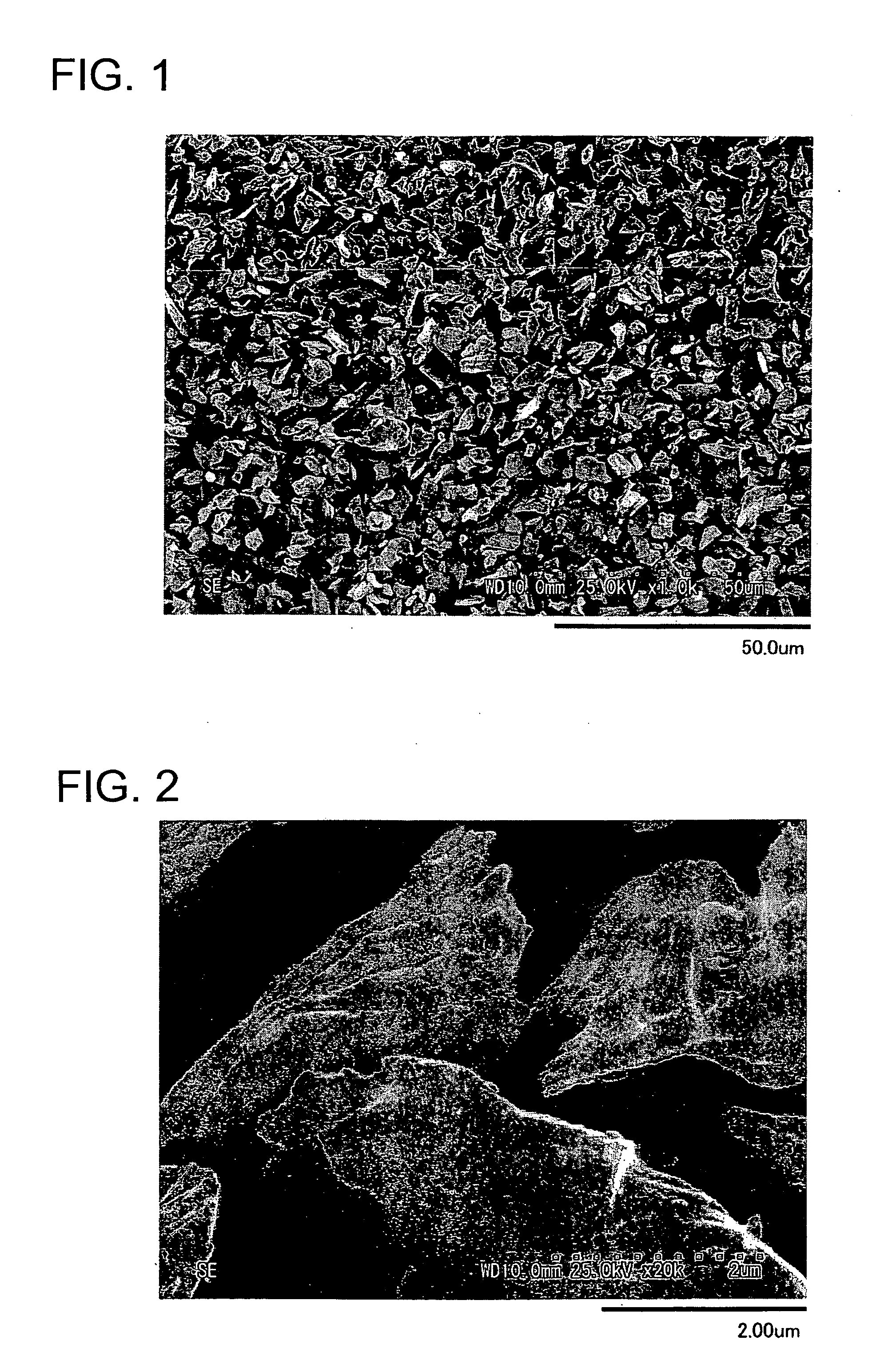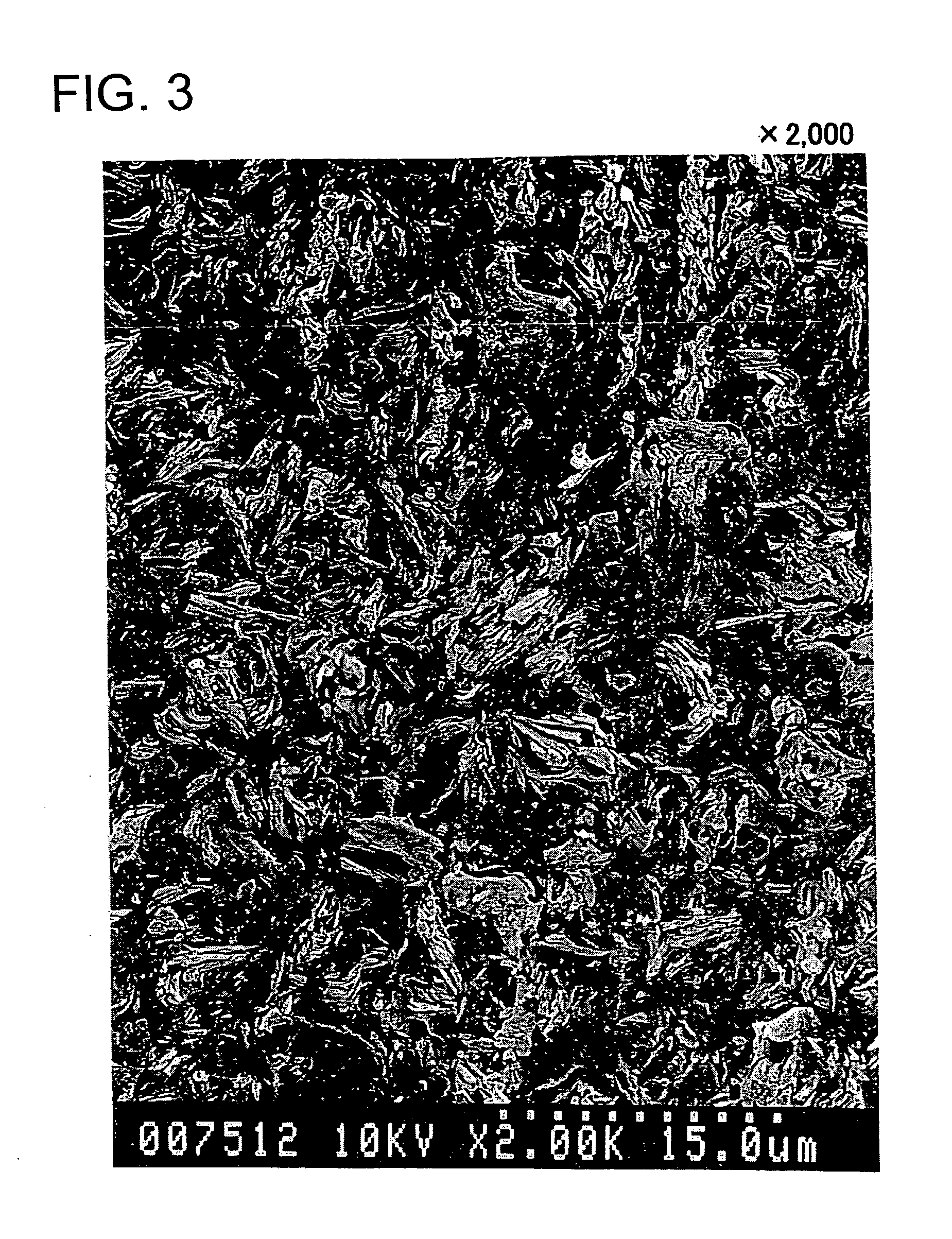Amorphous carbon particles and composite material used thereof
a technology of amorphous carbon and composite materials, which is applied in the direction of climate sustainability, solid waste management, sustainable waste treatment, etc., can solve the problems of less material strength than intended value, less activity or reactivity of unburned carbonaceous constituents, and high cost of amorphous carbon produced by burning and carbonizing thermosetting resins. , to achieve the effect of small specific surface area, small pore volume, and small specific surface area
- Summary
- Abstract
- Description
- Claims
- Application Information
AI Technical Summary
Benefits of technology
Problems solved by technology
Method used
Image
Examples
example 1
[0091] Preparation of Amorphous Carbon Particles
[0092] After petroleum coke had been burnt using the pulverized fuel boiler (combustion condition: combustion at 800-1300° C. under oxidation atmosphere), combustion ash which had been trapped with a dust extractor was collected.
[0093] When the composition of this combustion ash was analyzed, components' result was obtained as moisture 0.4% by weight, carbon content 86.3% by weight, hydrogen 0.21% by weight, oxygen 1.23% by weight, NH3 1.63% by weight, SO4 4.10% by weight, V 1.25% by weight, Ni 0.58% by weight, Fe 0.56% by weight, Mg 0.06% by weight, Ca 0.25% by weight, Na 0.16% by weight, Al 0.24% by weight, and Si 0.69%
[0094] To the obtained combustion ash, humidification treatment was applied. After the humidification treatment, acid water (5% sulfuric acid aqueous solution) 200 parts by weight was added to the combustion ash 100 parts by weight in a stirring vessel, and then, a reducing agent (sulfurous acid aqueous solution) 0....
examples 2-4
Preparation of Polypropylene Composite Materials
[0100] Amorphous carbon particles obtained in Example 1 were blended into polypropylene (SunAllomer PM9100A, manufactured by SunAllomer, Ltd.) in respective amounts shown in Table 1 in a biaxial extruder (manufactured by Berstorff GmbH, screw's diameter =43 mm, L / D=37), and they are fused and kneaded therein under the conditions of rotation rate 100 rpm, feeding rate 10 kg / min., pelletizer rate 15 m / min., and resin temperature 225-226° C. in order to prepare a composite material. The obtained composite material was molded as dumbbell specimens (ASTM D628 type I) and disk specimens (diameter 50 mm×thickness 3 mm, and diameter 100 mm×thickness 1.6 mm) by an injection molding apparatus (Klöbeckner F40)
[0101] With respect to the obtained composite materials, specific gravity (JIS K7112), tensile strength (ASTM D638), tensile elongation (ASTM D638), tensile elastic modulus (ASTM D638), bending strength (JIS K7171), bending elastic modulu...
example 5
Preparation of Polyamide Composite Material
[0103] 30% by weight of the amorphous carbon particles obtained in Example 1 were blended into 70% by weight of nylon 6 type polyamide (NOVAMID 1013C5, manufactured by Mitsubishi Engineering-Plastics Corporation), and then the blend was fused and kneaded with a kneader (TEX-30 biaxial kneader, manufactured by Japan Steel Works, LTD.) under the conditions of rotation rate 300 rpm, and resin temperature 270-280° C. in order to prepare a composite material. The obtained composite material was molded as dumbbell specimens (JIS No. 1 dumbbell) and flat plate specimens (length 80 mm×width 120 mm×thickness 2 mm) by injecting it into dies (JIS dies) with a molding apparatus (120T injection molding machine, manufactured by Japan Steel Works, LTD.).
[0104] With respect to the obtained composite materials, density (JIS K7112), tensile fracture strength (JIS K7113), tensile fracture elongation (JIS K7113), bending strength (JIS K7203), bending elasti...
PUM
| Property | Measurement | Unit |
|---|---|---|
| Temperature | aaaaa | aaaaa |
| Fraction | aaaaa | aaaaa |
| Percent by mass | aaaaa | aaaaa |
Abstract
Description
Claims
Application Information
 Login to View More
Login to View More - R&D
- Intellectual Property
- Life Sciences
- Materials
- Tech Scout
- Unparalleled Data Quality
- Higher Quality Content
- 60% Fewer Hallucinations
Browse by: Latest US Patents, China's latest patents, Technical Efficacy Thesaurus, Application Domain, Technology Topic, Popular Technical Reports.
© 2025 PatSnap. All rights reserved.Legal|Privacy policy|Modern Slavery Act Transparency Statement|Sitemap|About US| Contact US: help@patsnap.com


